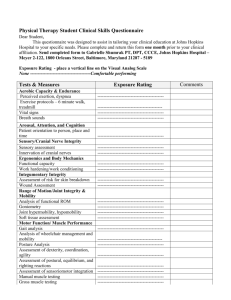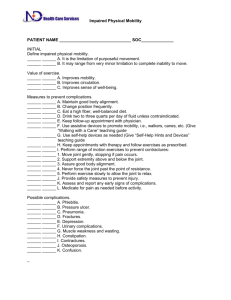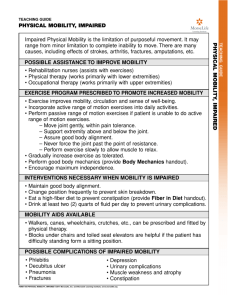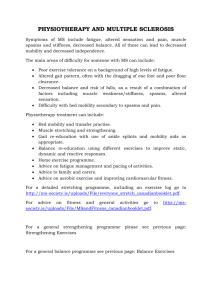Assisting with Cold and Heat Therapy and Ambulation
advertisement
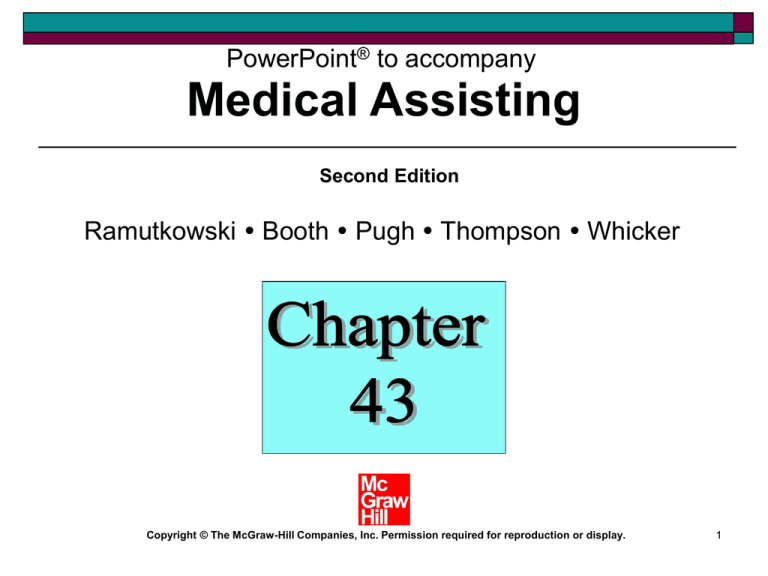
PowerPoint® to accompany Medical Assisting Chapter 43 Second Edition Ramutkowski Booth Pugh Thompson Whicker Copyright © The McGraw-Hill Companies, Inc. Permission required for reproduction or display. 1 Assisting with Cold and Heat Therapy and Ambulation Objectives: 43-1 Explain how medical assistants might assist with some forms of physical therapy. 43-2 Describe ways to test joint mobility, muscle strength, gait, and posture. 43-3 Discuss the benefits of cold and heat therapies. 43-4 List contraindications to cold and heat therapies. 43-5 Identify various cold and heat therapies. 43-6 Demonstrate how to perform cold and heat therapies. 2 Assisting with Cold and Heat Therapy and Ambulation Objectives (cont.) 43-7 Describe hydrotherapy methods. 43-8 Identify several methods of exercise therapy. 43-9 Compare different methods of traction. 43-10 Demonstrate how to teach a patient to use a cane, a walker, crutches, and a wheelchair. 3 Introduction Applying cold and You may also assist: heat therapy and Applying cold and heat assisting patients Teaching basic exercises with ambulation are Demonstrating the use common duties of a of cane, walker, and crutches medical assistant. Demonstrating how to use a wheelchair and discussing specific therapies with the patient for use at home are also duties that you may be asked to perform. 4 General Principles of Physical Therapy Physical therapy is a medical specialty for treatment of musculoskeletal, nervous, and cardiopulmonary disorders. 5 Assisting with a Therapeutic Team Therapeutic team Physicians Nurses Medical assistants Other specialists Coordinate schedules Making referrals Explaining treatment approach Documenting treatments You must have a working knowledge of therapy techniques. 6 Assisting with Patient Assessment Joint mobility testing – range of motion (degree to which a joint is able to move) using a goniometer Muscle strength testing – determine the amount of force the patient can exert using a 5-point scale Gait testing – way a person walks (gait and swing) Posture – body position and alignment 7 Cryotherapy & Thermotherapy Cryotherapy – applying cold to a patient’s body for therapeutic reasons Wet or dry Chemical or natural Ice packs or bags Thermotherapy – applying heat to a patient’s body for therapeutic reasons Dry heat Electric pads Heat lamps Hot soaks 8 Factors Affecting Use of Heat and Cold Age Treatment location Circulation or sensation impairment Temperature tolerance 9 Principles of Cryotherapy Physiologic responses to cold include: Prevention of swelling by limiting edema. Control bleeding by constricting blood vessels. Lowering body temperature. Reduction of pus formation by inhibiting microorganisms. Activity 10 Principles of Thermotherapy Physiologic responses to heat include: Relief of pain and congestion Reduction of muscle spasms Muscle relaxation Reduction of inflammation Reduction of swelling Chemical Hot/Cold Pack 11 Administering Thermotherapy Dry heat Chemical hot packs Heating pads Hot-water bottles Heat lamps Fluidotherapy Moist heat Hot soaks Paraffin bath 12 Administering Thermotherapy (cont.) Diathermy – heat therapy in which a machine produces high frequency waves that achieve deep heat penetration in muscle tissue Ultrasound Shortwave Microwave 13 Hydrotherapy Use of water to treat physical problems Whirlpools Contrast baths Underwater exercises 14 Apply Your Knowledge The physician has asked you to perform a moist heat application to a patient’s left leg. After about 10 minutes of treatment you check the area and notice it is very red, and the patient appears to be breathing fast. What should you do? 15 Apply Your Knowledge -Answer The physician has asked you to perform a moist heat application to a patient’s left leg. After about 10 minutes of treatment you check the area and notice it is very red, and the patient appears to be breathing fast. What should you do? Remove the application immediately and take the patient’s vital signs. Report the results to the physician. 16 Exercise Therapy Offer both preventive and therapeutic benefits Primary treatment for fractures, arthritis, and some respiratory diseases 17 Exercise Therapy (cont.) Exercise will help: Improve muscle tone and strength Prevent or correct physical deformities Promote neuromuscular coordination Improve circulation Relieves stress 18 Medical Assistant’s Role Provide information on various types of exercise problems and treatment plan. Serve as source of support and encouragement. Assist with ROM exercises. Teach the patient and family about ROM exercises. 19 Type of Exercise Active mobility – self directed exercises that patient performs without assistance Passive mobility – exercises the physical therapist or machine moves the patient’s body part Aided mobility – self directed with assistance of a device such as exercise machine Active resistance – works against resistance Isometric – patient relaxes and then contracts muscles ROM Exercises – moving each joint through its full range of motions 20 Electrical Stimulation Devices that deliver controlled amounts of low-voltage electric current to motor and sensory nerves to stimulate muscles. Prevents atrophy in muscles. Helps in healing injured joints. Retrain a patient to use injured muscles. 21 Apply Your Knowledge A patient reports to you that he is having a lot of muscle aches when he performs his ROM exercises. What suggestions could you give him to prevent and treat this problem? 22 Apply Your Knowledge -Answer A patient reports to you that he is having a lot of muscle aches when he performs his ROM exercises. What suggestions could you give him to prevent and treat this problem? To prevent the problem he should keep track of the number or repetitions and amount of weight and increase each of these slowly. To treat the problem he should rest and soak in a hot tub. 23 Traction The pulling or stretching of the musculoskeletal system to treat fracture bones and dislocation, arthritic, or other diseased joints. May be used to: Create and maintain bone alignment Reduce and prevent joint stiffening Correct deformities Reduce and relieve muscle spasms 24 Type of Traction Manual – performed by pulling a patient’s limb by using you hands. Static (weight traction) using a harness and weights to relieve muscle spasms. Skin – use of foam rubber and weights to prevent injury to the skin while decreasing muscle spasms. Skeletal – use pins, wires, or tongs inserted into bones which are attached to pulleys and weights for continuous traction. 25 Mobility Aids Devices to improve patients’ ability to ambulate Canes Walkers Crutches Wheelchairs 26 Mobility Aids (cont.) Canes Standard Patient who needs only small amount of support Tripod (3 legs) and Quad-base (4 legs) Create wide base of support Make them more stable than standard Can stand alone, free patient’s hands when they sit 27 Mobility Aids (cont.) Walkers Aluminum frame with four widely placed legs with rubber tips Legs are adjustable Used by older patients who are too weak to walk unassisted or who have balance problems 28 Mobility Aids (cont.) Crutches Allow patient to walk without putting weight on the feet or legs by transferring that weight to the arms. Aluminum or wood 29 Mobility Aids (cont.) Crutch gaits Four point – used for slow gait for a patient who can bear weight on both legs Three point – used when patient cannot bear weight on one leg Two point – used when patient can have some weight on both legs Swing point – used when patient has severe disabilities 30 Mobility Aids (cont.) Wheelchair Depends on patient’s disability and length of time wheel chair needed You may be responsible for transferring patient from wheelchair to exam table Ensure safety for patient and you by following transfer techniques. 31 Apply Your Knowledge When would a walker be an appropriate mobility device for use by your patient? 32 Apply Your Knowledge -Answer When would a walker be an appropriate mobility device for use by your patient? Walkers are used by older patients who are too weak to walk unassisted or who have balance problems. 33 Summary Medical Assistant You will be asked to help with cryotherapy, thermotherapy, and other treatments. You will need to teach a patient how to use mobility aids. 34 End of Chapter 35


